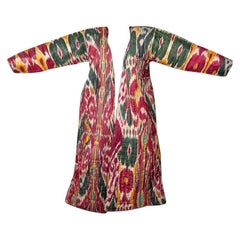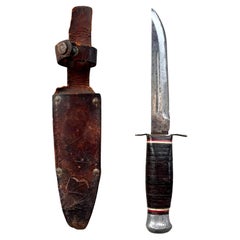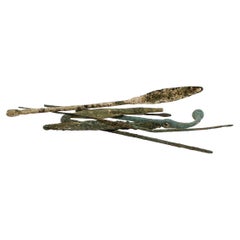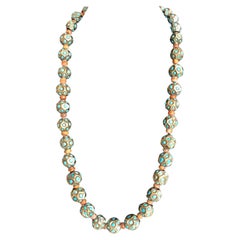Central Asian Antiquities
2
to
1
2
2
2
1
1
1
1
1
1
1
1
9,557
490
183
154
150
Place of Origin: Central Asian
Vintage Central Asian silver coral gemstone necklace Tribal Jewellery Gifts
Located in London, GB
Beautiful Vintage central Asian silver gilt coral and gemstone beaded necklace
A necklace of silver beads with high quality antique red coral amethyst and gemstones
Period: early...
Category
Mid-20th Century Central Asian Antiquities
Materials
Gold, Silver
Magnificent Silk Ikat Chapan, Uzbekistan, Xix Century
Located in San Pedro Garza Garcia, Nuevo Leon
Ikat Chapan – a man’s uzbek coat – Style Robe with exceptionally rich colour and dynamic pattering. Viewers may become lost in this ikat’s intertwining mot...
Category
15th Century and Earlier Antique Central Asian Antiquities
Materials
Cotton
Related Items
Japanese Camp Knife, 1960s Japan
Located in Los Angeles, CA
Fantastic Japanese camp knife with a leather sheath. Blade stamped 'Japan.' Traditional stacked leather handle in black with red and white accent rings. Full tang blade running strai...
Category
1960s Vintage Central Asian Antiquities
Materials
Metal
Group of Ancient Roman Bronze Tools & Hair Pins
Located in Philadelphia, PA
A fine group of ancient Roman bronze implements and artifacts.
Consisting of pins & several small scale tools.
From the private collection of Lawrence Majewski, who was a former co...
Category
15th Century and Earlier Classical Roman Antique Central Asian Antiquities
Materials
Bronze
Rare Suite of Antique Royal Horse Artillery 1 Cannon, 1873-1901 Coat Buttons
Located in GB
We are delighted to offer for sale this very nice suite of antique military officer Royal Horse Artillery (1 Cannon - 1873-1901) 18mm ball button with Queen Victoria's Crown brass Mi...
Category
Early 1900s High Victorian Antique Central Asian Antiquities
Materials
Brass
Antique Wooden Plate, Wabi Sabi Style, Scandinavia, 1800s
Located in Hønefoss, 30
A wonderful wooden wabi sabi plate from Scandinavia, circa 1800s. In good vintage condition showing beautiful patina from age and use.
Measures:
Ø: 2...
Category
19th Century Romantic Antique Central Asian Antiquities
Materials
Wood
Silver Handle Walking Stick, France, 1900
Located in Milan, IT
Walking stick: silver round knob handle. Ebony wood shaft. Metal ferrule. France 1900 ca.
Category
Early 20th Century Central Asian Antiquities
Materials
Metal, Silver
Early 20th Century, Antique Wooden Rocking Horse
Located in Leuven , BE
The rocking horse was made in the first half of the 20th century in the United Kingdom. The ears and the reigns are in light brown leather. The main and the tail of the horse are mad...
Category
Early 20th Century Central Asian Antiquities
Materials
Leather, Wood
Set of 3 Antique Root Bowls, Wabi Sabi Style, Scandinavia, 1800s
Located in Hønefoss, 30
A set of 3 wooden wabi sabi root bowls from Scandinavia, circa 1800s. In good vintage condition showing beautiful patina from age and use. One of the bowls has an old repair.
Mea...
Category
19th Century Romantic Antique Central Asian Antiquities
Materials
Wood
Raven Collection 19th Century Doll
Located in London, GB
The Raven collection 16th century Venetian doll
We are proud to offer an amazing museum quality 16th century Venetian doll still in its original linen and silk clothing. A wonderful...
Category
1820s Folk Art Antique Central Asian Antiquities
Materials
Wood
18th Century Swedish Decorated Mangle Board
Located in Kramfors, SE
Folk art mangle board from northern Sweden. This is a typical proposal gift to the would-be bride from the groom. If he had the skill the groom would make...
Category
Late 18th Century Folk Art Antique Central Asian Antiquities
Materials
Pine
Antique Mortar, Wabi Sabi Style, Scandinavia 1800s
Located in Hønefoss, 30
Wooden Wabi Sabi Mortar from Scandinavia, circa 1800s. In good vintage condition showing beautiful patina from age and use.
Category
19th Century Romantic Antique Central Asian Antiquities
Materials
Wood
Japanese Blacksmith Tongs and Woodcarver Brace Drill, Early 20th Century
Located in Miami, FL
REDUCED FROM $225....Antique Japanese Tools, a Blacksmith Tong Pincer and Woodcarver Brace Drill, both early 20th century. Most likely late Meij...
Category
Early 20th Century Japonisme Central Asian Antiquities
Materials
Iron
H 0.75 in W 12.75 in D 4.5 in
Large 19th Century French Copper Champagne Funnel Marked Courtois Ay 1806 Marne
Located in Haarlem, NL
Very large decorative antique copper funnel used for decanting Champagne.
This object was made in Ay, Marne, France. One of the Grand-Cru Champag...
Category
19th Century Antique Central Asian Antiquities
Materials
Copper
H 21.26 in Dm 19.69 in
Previously Available Items
Rare Antique Central Asian Faceted Silver Gilt Turquoise Necklace Jewelry Gifts
Located in London, GB
A wonderful very rare Central Asian necklace of multi faceted silver and gold gilt beads with small turquoise pieces in each faceted section, beautiful antique beads dating from 17/1...
Category
Early 17th Century Antique Central Asian Antiquities
Materials
Gold, Silver
Free Shipping
H 29.93 in W 0.6 in D 0.6 in
Bactrian Marble Disc Idol on Custom Mount
Located in Chicago, IL
A stunning hand-carved marble Bactrian Disc idol with linear grooves on both sides, mounted on a custom steel mount. Bactrian idols originate from North-...
Category
15th Century and Earlier Antique Central Asian Antiquities
Materials
Marble
Important Gold Fragment
Located in London, GB
This fragment forms part of the famed Ziwiye hoard of treasure, reputably found in 1947 in modern day Kurdistan. As the contents of a royal tomb of a great ancient king, the pieces were quickly dispersed and only in the following years did the huge significance become understood in scholarship. These objects have become famous as the keystone in explaining underpinning socio-economic and political cultural ties across the silk route, reflected by these works of art. These objects exhibit styles and motifs associated with the four pre-eminent cultures at this juncture in history: Assyrian, Scythian, proto-Achaemenid and the provincial native pieces. The Scythians, a seminomadic people from the Eurasian steppes who moved out from Southern Russia into the territory between the Don and the Danube and then into Mesopotamia are responsible for the basis of an ‘animal style’ design found on the elaborate metalwork and jewellery produced in Central Asian ancient world. This style starts to appear in the 7th century B.C typically on pierced plaques made of gold and silver, which depict running or fighting animals (reindeer, lions, tigers, horses) alone or in pairs facing each other, embossed with powerful plasticity and free interpretation of the forms. The animal- style had a strong influence in western Asia during the 7th century B.C. Such ornaments as necklaces, bracelets, pectorals, diadems, and earrings making up the Ziwiye treasure (discovered in Iran near the border between Kurdistan and Azerbaijan) provide evidence of this Asiatic phase of Scythian gold...
Category
15th Century and Earlier Antique Central Asian Antiquities
Materials
Gold
Sino-Siberian Dagger
Located in London, GB
The nomadic nature of the Eurasian steppe tribes allowed for much integration and exchange of styles and customs, as well as physical transportable objects; including personal ornamentation and weaponry. Particularly between the Scythian tribes of the Black sea region in the West, Central Asian tribes such as the Hephthalites, the Wushu, Yuezhi and Mongolians to the East and the Persians further South. The blade of this piece has strong ties to daggers of the late Chinese Shang...
Category
15th Century and Earlier Antique Central Asian Antiquities
Materials
Bronze
The 'George Sand' Bull
Located in London, GB
The Amlash culture is known almost exclusively through the archaeological record that has come to light in recent decades. The term refers to the material culture found in the modern...
Category
15th Century and Earlier Antique Central Asian Antiquities
Materials
Terracotta
'Damon' Candlestick
Located in London, GB
Resting on a wide, trumpeted foot, this wonderful candlestick rises from a band of chased keyfret motif to a body of open pierced fretwork, which consists of thuluth calligraphy agai...
Category
15th Century and Earlier Antique Central Asian Antiquities
Materials
Copper
Minai Ceramic Jug
Located in London, GB
A polychrome Minai (enamel) handled cup from the latter half of the Turco-Persian Seljuq period (1040 - 1307), most probably from Kashan, a significant centre of ceramics production during this time where potters moulded, fired and painted both Minai and lusterware works. This handled cup rises from a short foot and widens to a spherical body, which tapers towards its neck at its widest point, emphasizing its curvature, and flares slightly at its rim. The artist has painted figures upon horseback, rendered in vibrant colours and outlined in black and gold, on the central frieze that encircles the body. Above the figures runs a blue band of Arabic calligraphy, written in Kufic script, while on the same spot in the interior of the cup there is a band of orange calligraphy, executed again in the Kufic style. The handle is S-shaped with a delicate, pale green scrolling pattern, which couples to underscore its function as a drinking utensil, along with its opulence; a luxurious example of the material culture of pre-Mongol Iran. Minai means enamel in Persian, and the term refers to this type of pottery’s colourful decoration, which lies both in and over the glaze, here further enriched with gold (gilding) which is visible on the horse’s reigns and the bows on their tails. Only certain colours are fixed as over glazed enamels. Some, such as turquoise, blue and purple are normally painted into the opaque white glaze after it has been applied and are fixed with it in the firing. Enamel pigments are then painted, and fixed in the second firing. These are normally restricted to red and black, but in more ambitious pieces, such as in this case, a whole range of other enamel colours are found together with gold gilding. Such Minai works had to be fired twice in order to achieve their polychromatic harmonies and were consequently the most sought-after and costly wares; we can thereby infer that the patron or owner was likely to have been a member of the Seljuq elite. The Seljuqs descended from nomads (specifically the Turkic Oghuz clan) who grazed cattle on the Central Asian land that the previous Persian dynasty...
Category
15th Century and Earlier Antique Central Asian Antiquities
Materials
Ceramic
Kashan Lustre Vase
Located in London, GB
It has long been conjectured, though there is no proof, that at the end of the twelfth century a group of Egyptian potters fled the rapidly declining Fatimid caliphate and settled in...
Category
15th Century and Earlier Antique Central Asian Antiquities
Materials
Ceramic
Fragment of a Scabbard Terminal
Located in London, GB
Taken from a larger gypsum wall carving, this triangular fragment displays the hilt and scabbard of a dagger or ‘akinakes’. Decorated with a pair of outward facing rampant lions, eac...
Category
15th Century and Earlier Antique Central Asian Antiquities
Materials
Stone
Antique 19th Century Hand Carved Afghan Chief's Chair with Stool
Located in Peabody, MA
A mid to late 19th century Afghan armchair and stool, back panel ornamented with chip carving of tribal designs. Fashioned of Himalayan cedar and goat-hide and pegged together withou...
Category
19th Century Tribal Antique Central Asian Antiquities
Materials
Hide, Cedar
Recently Viewed
View AllMore Ways To Browse
French Bedside Cabinets Antique Furniture
Shop Chest
Antique Style Chinese Cabinet
Open Storage Console
Italian Neoclassical Commode
Museum Cabinet Glass
Small Chest Of Drawers With Marble
Wall Shelves Glass Doors
Antique Teak Cabinet
Vintage Jewellery Chest
Deco Door Pull
Antique Metal Trim
Metal Glass Display Cabinet
Mahogany Chest Of Drawers With Doors
Glass And Metal Display Cabinets
Small Shelf Desk
Spanish Hardware
Chinese Cabinet Chinoiserie





